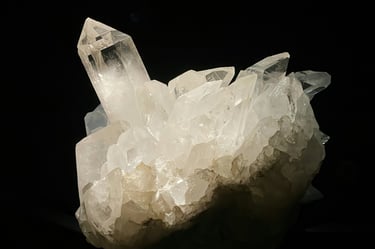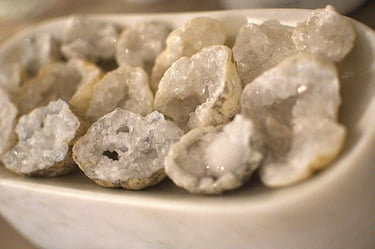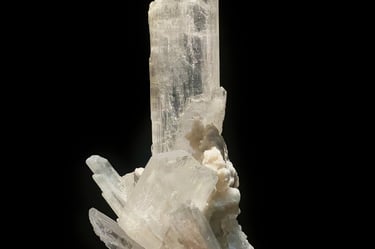White Quartz
Clarity · Purity · Healing · Amplification
Metaphysical Properties:
White Quartz is often referred to as the “Master Healer” crystal, owing to its ability to amplify energy and enhance the properties of other stones. It is known for its cleansing, purifying, and balancing qualities, making it a versatile stone for various spiritual practices. It enhances clarity of thought, aids in clearing negative energy, and brings emotional balance.
Symbolism & Associations:
White Quartz is associated with spiritual growth, purification, and clarity. It is often linked to the energies of the Crown Chakra, facilitating higher states of consciousness, spiritual awareness, and communication with higher realms. It is a stone of purity and enlightenment, used to bring clarity to the mind and heart.
Chakra Alignment:
White Quartz is primarily connected to the Crown Chakra, assisting with spiritual enlightenment, meditation, and connection to higher consciousness. It can also assist in clearing blockages in other chakras due to its overall purifying and balancing energy.
Planets:
Uranus
Zodiacs:
Gemini, Virgo, and Capricorn
Elements:
Air
Similar Stones:
Selenite, Calcite, Aura Quartz (Treated — non-natural stone), Crystallized Agate
Correspondences:
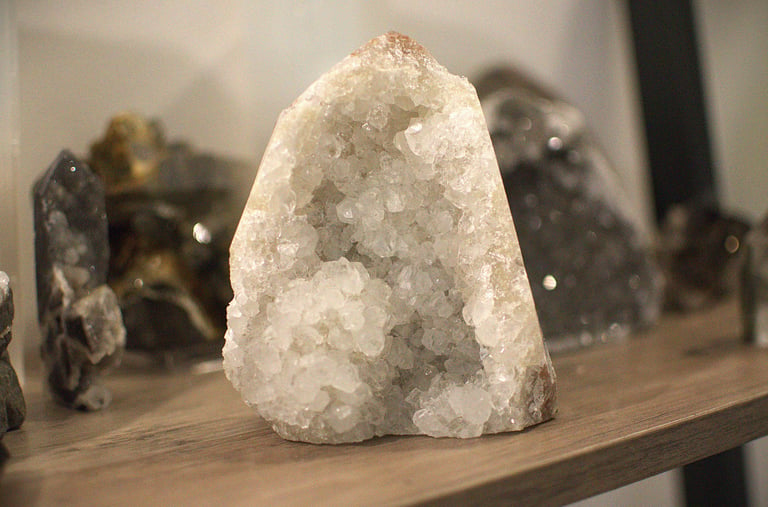

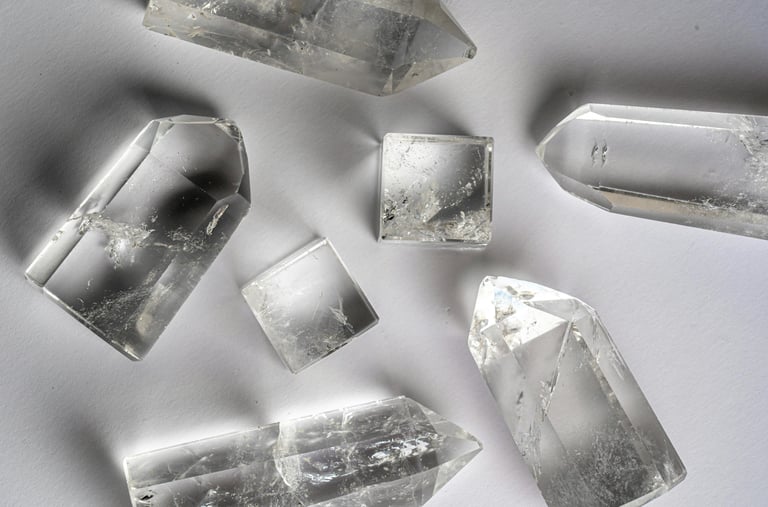

Facts
Stone Type:
Quartz
Hardness Rating:
7 on the Mohs scale, making White Quartz durable and suitable for daily wear. Though fairly tough, care should be taken to avoid scratches from harder materials.
Chemical Formula:
SiO₂ (Silicon Dioxide)
Care Guide
White Quartz has a Mohs hardness of 7, making it durable for everyday wear. Clean with warm, soapy water and a soft cloth; avoid harsh chemicals or ultrasonic cleaners. Store it separately from harder gemstones to prevent scratches.
Spiritual
White Quartz is a master healer that amplifies energy, enhancing spiritual growth and manifesting intentions. It deepens meditation, promoting clarity and connection to higher realms. The crystal also cleanses and balances energy, removing blockages and supporting physical, emotional, and spiritual healing.
Healing
White Quartz is believed to support the immune system, balance energy levels, and aid in detoxification. It can help with improving memory, focus, and mental clarity. It’s also known for promoting overall well-being, including easing stress and reducing tension in the body.
Cleansing
White Quartz can be cleansed using water (though avoid prolonged soaking), sage smoke, incense, or sound vibrations like tuning forks or singing bowls. Regular cleansing helps maintain the crystal’s energetic strength.
Affirmations
“I am pure, balanced, and open to spiritual growth.”
“I embrace clarity and release all negative energy.”
“I am a vessel for divine healing energy.”
“I trust in the power of transformation and enlightenment.”
Meditation
White Quartz is ideal for meditation. Hold it during your practice to amplify intentions, promote clarity, and facilitate spiritual growth. It can also be used for visualization exercises to clear mental fog and assist with focusing on spiritual pursuits.
Astrology
White Quartz is associated with Uranus, the planet of change, spiritual awakening, and innovation. It is also linked to the Crown Chakra, supporting enlightenment and connection with the divine.
Vibration
White Quartz vibrates at a high frequency, facilitating spiritual clarity and enlightenment. Its energy is pure and cleanses the mind and body of negative energy, helping to restore balance and harmony.
Did You Know:
White Quartz is often referred to as the "master healer" because of its ability to amplify the properties of other crystals. It is one of the most common minerals on Earth and can be found in nearly every part of the world. White Quartz is used in various spiritual practices, from meditation to energy healing, due to its ability to channel healing energies and enhance intentions.
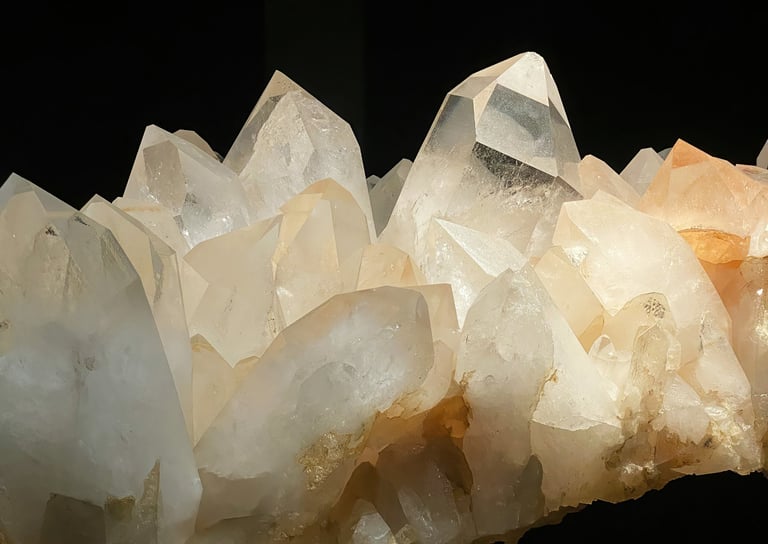

Mythology & Folklore
White Quartz, like many crystals, has deep-rooted significance in various mythologies and cultural beliefs. In ancient Greece, it was believed that clear Quartz was water that had frozen so deeply that it turned to stone. This belief led to the association of Quartz with eternal life, as it was thought to be unchanging and indestructible. In some traditions, Quartz was considered a stone of the gods, with its purity symbolising divine power and wisdom.
In medieval Europe, Quartz was often used in sacred rituals and was believed to have protective properties. It was thought to shield the wearer from harm, as well as to bring clarity of mind and insight. During this time, Quartz was also thought to connect the wearer to spiritual realms, facilitating communication with higher beings.
Indigenous cultures across North America, particularly the Native American tribes, viewed Quartz as a sacred stone. They believed it had the power to heal, purify, and amplify the energies of the earth. Some believed Quartz had the ability to connect humans to the spirit world and could be used to call upon ancestral wisdom.
In Eastern spiritual practices, particularly in Taoism and Chinese medicine, Quartz was revered for its ability to channel energy. It was believed to balance the flow of energy, or "chi," in the body and environment, bringing harmony and peace.
In modern metaphysical beliefs, Quartz is still regarded as a powerful healing stone, with its energy linked to the purification of the mind, body, and soul. It's often used to promote clarity, focus, and healing in meditation and spiritual practices, as well as being a symbol of protection and enlightenment.
Historical Significance
White Quartz has been used throughout history in a wide variety of ways, due to its abundance and unique properties. As one of the most widely distributed minerals on Earth, its historical presence can be traced back thousands of years across many ancient cultures.
In prehistoric times, early humans used Quartz crystals in the form of tools and weapons. It was often flaked into sharp edges, making it useful for cutting, hunting, and survival purposes. The clear, reflective nature of Quartz also led early humans to use it for creating polished surfaces and items such as mirrors, which were considered sacred and used in spiritual rituals. These early forms of Quartz were instrumental in human development, symbolising the advancement of both practical and mystical understanding.
In Ancient Egypt, Quartz was associated with the divine and the afterlife. It was used in burial artifacts and jewellery, as the Egyptians believed that Quartz had the ability to harness and amplify energy. They would carve the stone into intricate designs and use it in temples, as well as for the creation of amulets, with the intention of protecting the wearer from harm and aiding in their transition to the afterlife. The use of Quartz in these sacred rituals signified its importance in the ancient world, not only for practical purposes but also as a conduit for spiritual energy.
Throughout the Roman Empire, Quartz was utilized for its optical properties. It was used as lenses in spectacles and was even carved into decorative items such as bowls and statues. Romans believed Quartz had magical and healing properties, using it in elixirs and potions to promote health and longevity. Quartz’s clear, transparent quality made it a highly prized stone, symbolising clarity, wisdom, and the purity of the soul.
In the Middle Ages, Quartz’s symbolic association with purity and clarity carried through, with the stone being used in alchemical practices. Alchemists believed that Quartz could amplify the power of their elixirs, potions, and spells. They would often use Quartz as a vessel to store their concoctions, believing that its crystalline structure could enhance the potency of the mixtures. This association with alchemy also carried over into medieval religious practices, where Quartz was used in sacred rituals and believed to hold spiritual energy capable of connecting humans to divine forces.
During the 18th and 19th centuries, Quartz saw a rise in popularity among gemstone collectors and was used to create fine jewellery. Its natural abundance made it more affordable compared to rarer stones, but its unique beauty and versatility ensured its place in both fine art and ornamentation. The Victorians, in particular, valued Quartz for its spiritual properties, often wearing it in rings, brooches, and necklaces as a symbol of clarity and spiritual awakening.
In modern times, Quartz continues to be widely used, both as a decorative stone and in healing practices. Its significance in the New Age movement has led to its widespread use in meditation, energy work, and crystal healing. It is believed that the stone amplifies intentions and connects individuals to higher planes of consciousness. The historical significance of Quartz has evolved over time, transitioning from a practical tool to a symbol of spiritual growth, healing, and energy amplification.
Origin & Formation
White Quartz, also known as Clear Quartz, is one of the most abundant and widely distributed minerals on Earth, found in a wide variety of geological environments. Its formation begins in the Earth's crust, typically through the cooling and crystallization of molten rock, a process that can take millions of years. Quartz forms in a variety of environments, including igneous, sedimentary, and metamorphic rock formations, making it a versatile and widely found mineral.
Quartz is a silicate mineral composed of silicon dioxide (SiO₂). It forms in the Earth's crust through a variety of processes. The most common form of Quartz, clear or white Quartz, typically forms as a result of the cooling and solidification of molten rock (magma) from volcanoes. This type of Quartz is most commonly found in igneous rocks like granite, rhyolite, and basalt. As the molten rock cools, the silicon dioxide crystallizes into a hexagonal pattern, forming Quartz crystals. Over time, these crystals grow larger as additional minerals and elements are incorporated into the structure.
White Quartz is typically formed in regions with high heat and pressure, where large amounts of silicate material accumulate and crystallize. These conditions allow for the formation of both large and small Quartz crystals. Sometimes, the Quartz will appear white due to the inclusion of air bubbles, water, or minerals during the crystallization process, creating the cloudy, translucent appearance that many associate with clear Quartz.
White Quartz is found in a vast range of locations across the world. Major deposits are found in countries such as Brazil, the United States, Madagascar, Russia, India, and Switzerland. In these regions, Quartz can be mined from various rock types, including granite and quartzite. The deposits form in both veins and large masses within the Earth’s crust, and because Quartz is so abundant, it can be found in many geological environments, from mountainous regions to riverbeds and deserts.
In Brazil, for example, Quartz is found in large, clear, and beautifully formed crystals. The state of Minas Gerais is one of the most significant sources of high-quality Quartz, producing large quantities of transparent or white Quartz used in both jewellery and metaphysical practices. Other significant Quartz deposits are found in Arkansas, USA, where some of the largest and clearest Quartz crystals are harvested.
Variation & Quality
White Quartz, while most commonly seen in its clear or cloudy form, is a mineral that exhibits a wide range of variations, qualities, and forms depending on the conditions in which it forms. These variations can affect both the appearance and metaphysical properties of the crystal, making White Quartz a highly versatile stone in terms of both aesthetics and use.
Clear Quartz:
The most well-known and widely used variety of White Quartz is Clear Quartz, which is transparent and colorless. This form is often considered the purest type of Quartz due to its clarity. Clear Quartz is highly valued in metaphysical practices for its ability to amplify energy and enhance spiritual clarity. It is frequently used in energy healing and meditation, as well as in jewellery and ornamental pieces. Clear Quartz is usually found in veins or large deposits and is typically mined in places such as Brazil and Arkansas, USA.
Milky Quartz:
Milky Quartz, also known as “White Quartz,” is another common variety, characterized by its opaque, white colouration. This variety is regularly cloudy or frosted in appearance due to tiny gas bubbles or inclusions trapped within the crystal during its formation. Milky Quartz is a less clear form of Quartz and is believed to have a calming, soothing energy. It is frequently used in crystal healing to provide emotional support, balance, and protection.
The cloudy appearance is caused by trapped air or water, which creates a soft, diffused look. Milky Quartz is commonly found in many of the same locations as Clear Quartz, including Brazil, Madagascar, and India.
Rutilated Quartz:
Rutilated Quartz is a variety of Quartz that contains inclusions of rutile, a titanium dioxide mineral that forms golden, red, or black needle-like structures within the Quartz crystal. These inclusions are what give Rutilated Quartz its distinctive, striated appearance. It is said to enhance the metaphysical properties of White Quartz, bringing clarity and focus to the mind. Rutilated Quartz is believed to help with mental clarity, spiritual growth, and emotional healing.
Rose Quartz & Pink Quartz:
While typically considered a separate mineral, Rose Quartz is actually a pink variety of Quartz that contains trace amounts of titanium, iron, or magnesium. It’s often mistaken for White Quartz but has a soft pink hue that makes it stand out. Rose Quartz is associated with love, compassion, and heart-healing, and is a favourite in metaphysical practices related to the heart chakra. While not exactly the same as White Quartz, it shares many of the amplifying properties and can be used in similar ways.
Smoky Quartz:
Another variation, Smoky Quartz, is a gray to brown variety of Quartz that is caused by natural irradiation from uranium deposits in the Earth. While it is typically not “white,” Smoky Quartz has been included here for its connection to Quartz. This form is known for its grounding and protective qualities. Smoky Quartz is said to help with emotional healing, energy clearing, and transformation, making it a valuable stone for cleansing and protection.
Chlorite Quartz:
Chlorite Quartz contains inclusions of chlorite, a mineral that typically appears green. This variation is often referred to as “Garden Quartz” or “Lodolite,” as the green chlorite inclusions can resemble foliage, moss, or even a garden-like scene within the crystal. This variety is believed to have healing properties related to growth, rejuvenation, and the heart chakra. It is typically used in meditation and energy work to encourage spiritual growth and physical healing.
Phantom Quartz:
Phantom Quartz features an internal “phantom” or shadow of a previous crystal formation, giving it a unique and fascinating look. These phantoms can appear as a faint outline of another crystal within the main crystal. Phantom Quartz is associated with deep spiritual transformation and is believed to provide guidance through life’s transitions. It is used in meditation for past-life work, ancestral healing, and personal transformation.
Faden Quartz:
Faden Quartz is characterized by a thread-like inclusion running through the centre of the crystal, which is often visible to the naked eye. The term “Faden” comes from the German word for “thread” or “string,” and the inclusion resembles a delicate thread through the crystal. Faden Quartz is known for its ability to connect energies and is used in healing practices to enhance the connection between the physical and spiritual realms. This form of Quartz is believed to assist in healing energetic blockages, helping to restore balance and unity.
Lodolite (Garden Quartz):
Lodolite, also known as “Garden Quartz,” is a type of Quartz that contains inclusions of various minerals, including iron, chlorite, and feldspar. These inclusions create beautiful and colourful patterns inside the crystal, typically resembling moss, foliage, or even landscapes. Lodolite is known for its calming energy and is believed to assist in emotional healing, meditation, and inner peace. It is often used for grounding and connecting to nature.
Ice Quartz:
Ice Quartz, also known as Snow Quartz, is a milky white variation of Quartz that resembles frosty ice crystals. It is typically used for protection and emotional healing, especially in areas where energy is particularly dense or chaotic. Ice Quartz is said to bring a sense of peace and tranquillity, helping to purify and cleanse the mind, body, and spirit.
Frosted Quartz:
Frosted Quartz is similar to Milky Quartz, but has a more pronounced frosted appearance due to the dense inclusions or mineral deposits within the crystal. This variation is sometimes found in geodes or as clusters of crystals, and it is thought to have a particularly strong healing energy. Frosted Quartz is used for stress relief, emotional healing, and calming the mind. It is also believed to enhance intuition and spiritual growth.
Quality Factors:
The quality of White Quartz is primarily determined by its clarity, size, and lack of inclusions. The clearest crystals, with no air bubbles or mineral inclusions, are typically considered the most valuable. However, the presence of inclusions can also add to the beauty and uniqueness of the crystal. The size and weight of the crystal can also influence its value, with larger, well-formed pieces often fetching higher prices. In metaphysical uses, the energy of the crystal is more important than its appearance. White Quartz is prized for its ability to amplify energy and promote spiritual clarity, making it a sought-after stone for both healing and decorative purposes.
Notes
White Quartz is one of the most versatile and widely used crystals in both the metaphysical and mineralogical worlds. Known for its amplifying properties, White Quartz is often referred to as the “master healer” due to its ability to enhance the energy of other crystals and help balance the body, mind, and spirit. This crystal is a powerful tool for those seeking clarity, healing, and spiritual connection, and its uses span a variety of practices from meditation to energy work.
Popularity in Jewellery and Decorative Items:
White Quartz is a popular choice for jewellery due to its timeless, neutral colour, making it suitable for almost any style or occasion. It's typically used in rings, necklaces, bracelets, and earrings, as well as in decorative home items like candleholders, pendants, and carved figurines. White Quartz is frequently paired with other crystals in jewellery designs, such as Amethyst, Rose Quartz, or Citrine, to enhance their properties and energy.
Energy Amplification:
One of the most notable metaphysical properties of White Quartz is its ability to amplify the energy of other crystals. It is commonly used in crystal grids, where it is placed strategically around other stones to boost their effects. White Quartz is also believed to have the ability to store energy and release it when needed, making it an ideal tool for energy work and healing.
Cleansing and Protection:
Due to its purifying properties, White Quartz is often used in cleansing rituals to remove negative energy and clear blocked energies from spaces and individuals. It's believed to purify not only the physical environment but also the spiritual body, clearing away stagnant or harmful energies. White Quartz is frequently used as a protective stone to create energetic shields around individuals and spaces.
Meditation and Spiritual Growth:
White Quartz is widely used in meditation practices for its ability to promote deep concentration and spiritual awareness. It is said to help one achieve a higher state of consciousness, making it a favoured stone for spiritual seekers. It's regularly used in meditation to gain clarity on difficult situations or to connect with higher realms of knowledge and understanding. When used during meditation, it can help promote stillness and focus the mind, allowing the practitioner to access deeper levels of insight and guidance.
Environmental Benefits:
White Quartz is also used for environmental healing. Its ability to purify and amplify energy makes it a beneficial stone to use in spaces where energy feels dense or out of balance. Many people place White Quartz in their homes or workspaces to promote a harmonious and uplifting environment. It's also often used in sacred spaces, altars, and healing rooms to enhance the vibrational energy and encourage spiritual growth.
Cultural & Historical Significance:
Throughout history, Quartz has held a prominent place in many cultures around the world. In Ancient Egypt, Quartz was used for its supposed healing properties, and it was frequently incorporated into amulets, jewellery, and burial items. In other cultures, such as Native American traditions, Quartz was revered for its ability to channel spiritual energy and enhance communication with the divine. Many ancient civilizations believed Quartz to be a “living” stone, capable of holding the energy of the earth and sky within its structure.
Environmental Considerations:
While White Quartz is abundant and widely available, it is important to consider ethical sourcing when purchasing this crystal. As with all minerals, it is crucial to ensure that Quartz is sourced responsibly, with attention to fair labour practices and environmental sustainability. Many crystal shops and jewellery designers are making efforts to ensure that the Quartz they use comes from sources that are mindful of the planet's well-being and its people.
